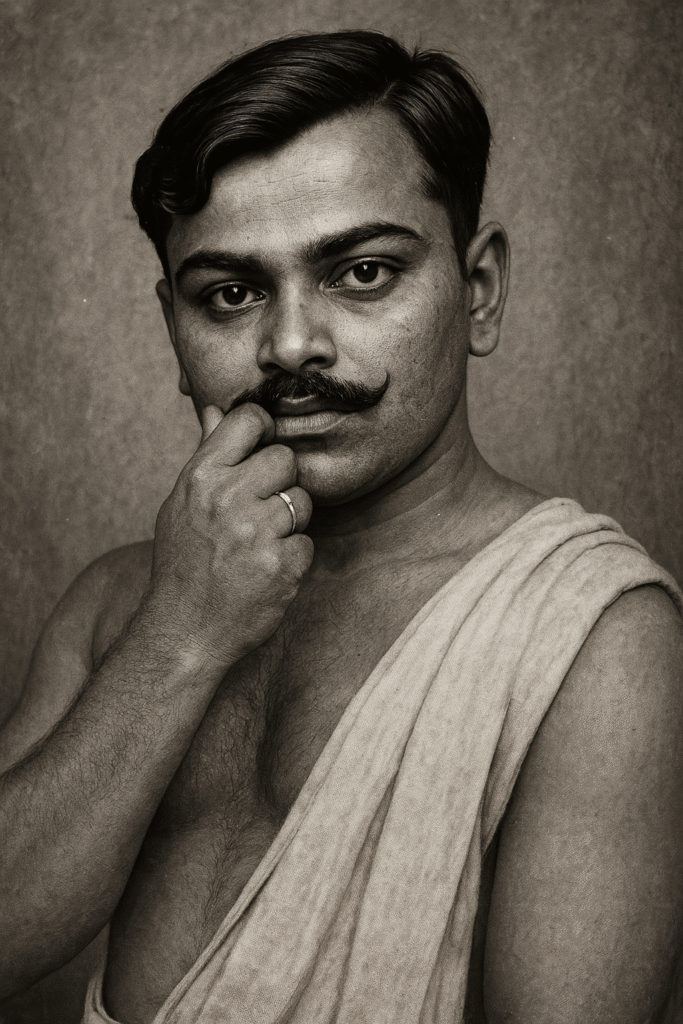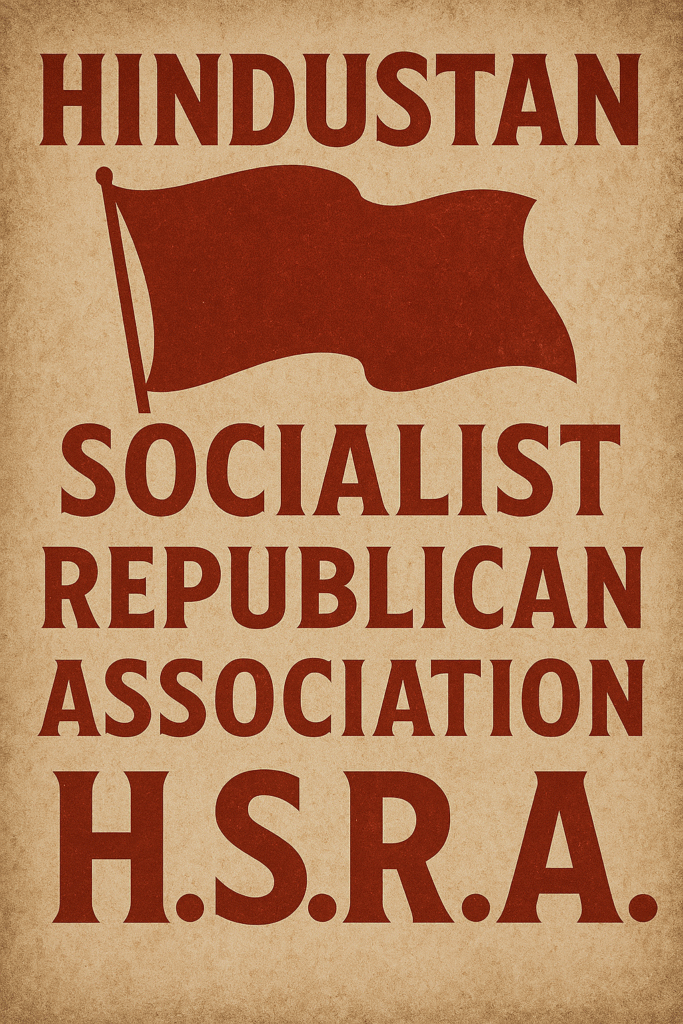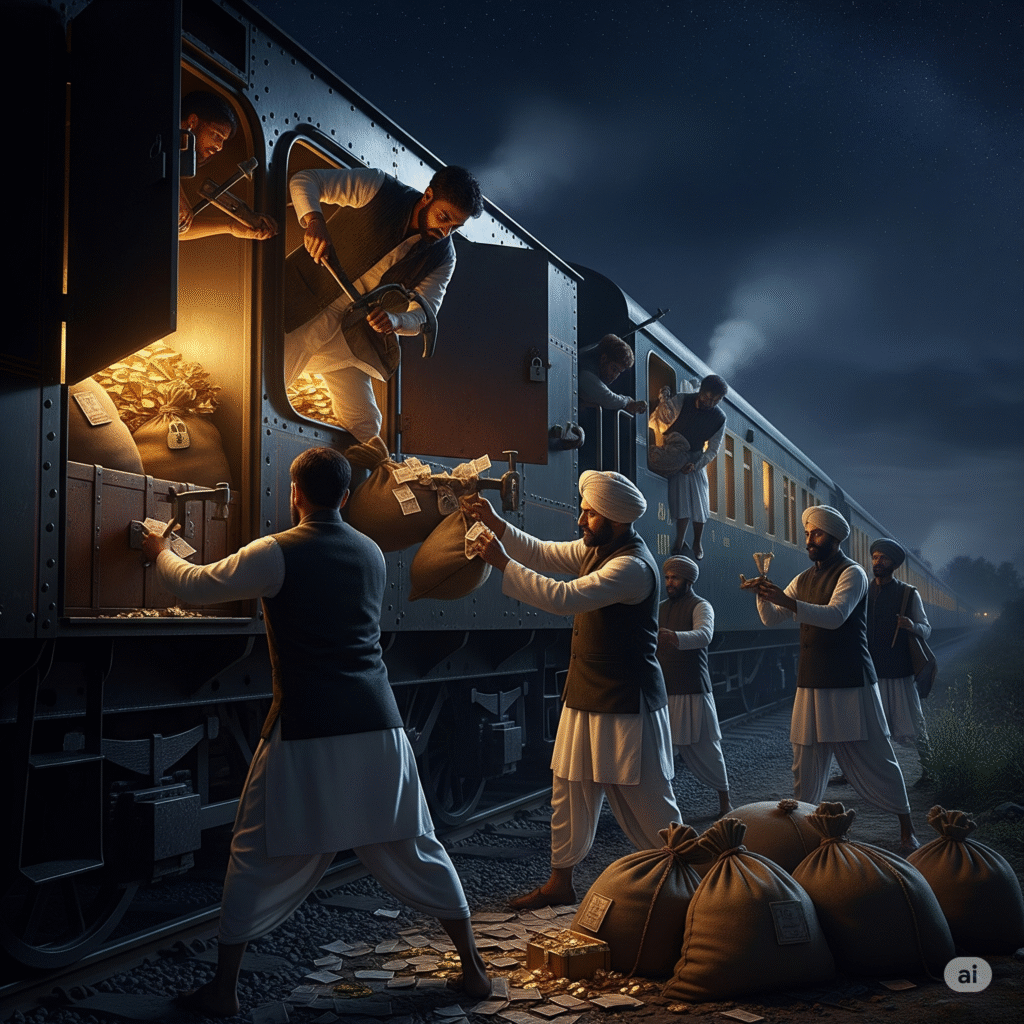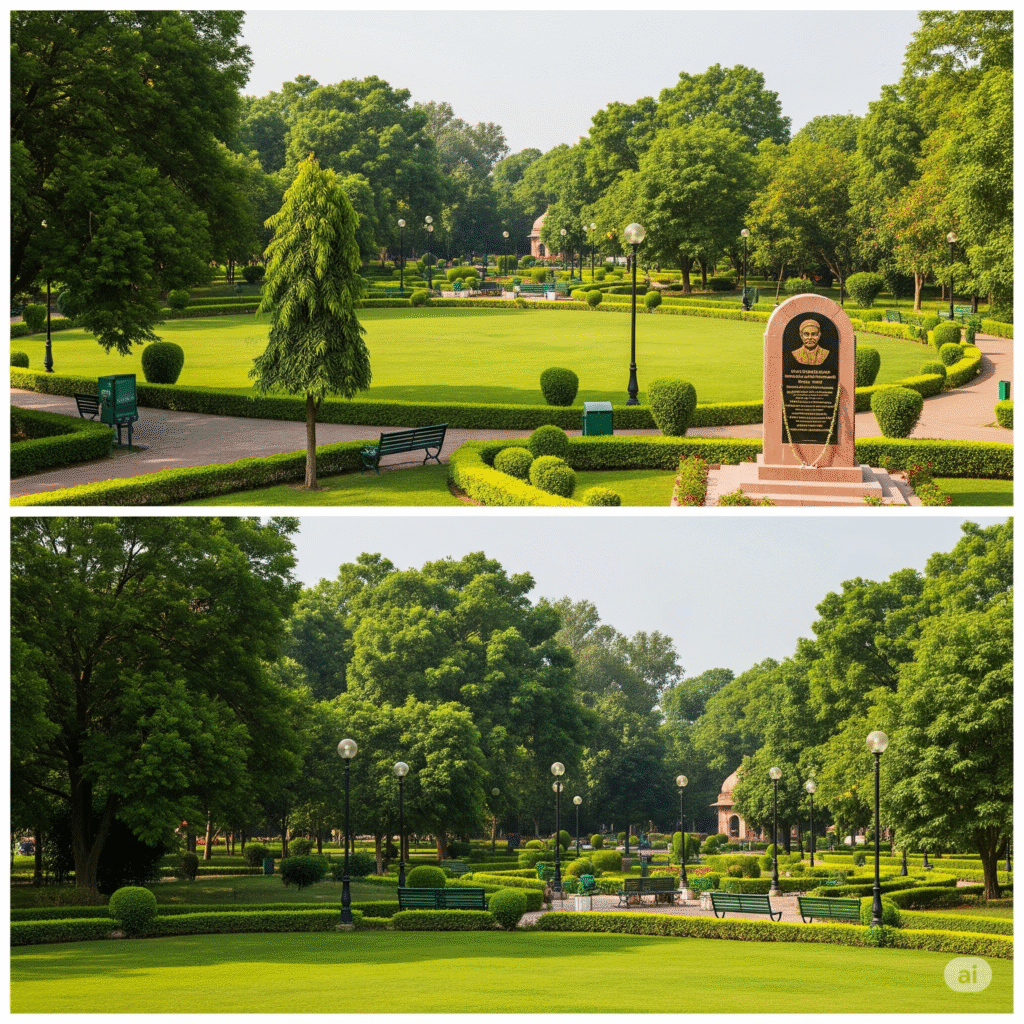
Name: Chandrashekhar Tiwari (named during the freedom struggle – Chandrashekhar Azad)
Birth: 23 July 1906
Birthplace: Bhabhra village, Alirajpur district, Madhya Pradesh
Death: 27 February 1931 (age 24 years)
Death place: Allahabad (now Prayagraj), Uttar Pradesh
Nationality: Indian
Fame: Great revolutionary of India, member of ‘Hindustan Socialist Republican Association (HSRA)’
🔹 Early life
Chandrashekhar Azad was born in a simple Brahmin family. His father’s name was Pandit Sitaram Tiwari and mother’s name was Jaggarani Devi. His childhood was spent in poverty. He was sent to Varanasi for studies, where he was influenced by the freedom movement along with studying Sanskrit.
🔹 Beginning of revolutionary life
At the age of 15, he joined the Non-Cooperation Movement (1921). When he was first caught by the British police, he told the court that his name was “Azad”, father’s name was “Swatantrata”, and place of residence was “jail”. From then on, he was named “Chandrashekhar Azad”.
🔹 Hindustan Socialist Republican Association (HSRA)
He soon joined the great revolutionaries Ram Prasad Bismil, Bhagat Singh, Rajguru, Sukhdev etc. and became an active member of HSRA.
Some major incidents:
- Kakori incident (1925): Looted government treasury from the British train.
- Revenge for the murder of Lala Lajpat Rai (1928): Involved with Bhagat Singh and Rajguru in the murder of Saunders.
- Viplav Yojana: Made plans to overthrow the British government.
🔹 Death
On 27 February 1931, Azad was caught in an encounter with the British police at Alfred Park (now Chandrashekhar Azad Park). He, as per his vow that “the British police will never be able to catch him alive” – shot himself with the last bullet and became a martyr.
🔹 Chandrashekhar Azad’s motto
“I was free, am free and will remain free.”
🔹 Legacy
- Chandrashekhar Azad’s martyrdom became a source of inspiration for the Indian youth.
- Many parks, schools and institutions have been built in his name.
- Alfred Park in Allahabad is now known as Chandrashekhar Azad Park.
- His sacrifice has been shown many times in Indian cinema as well.
🔹 Conclusion
Chandrashekhar Azad is a name who dedicated his life for the nation. His courage, determination and patriotism filled new energy of revolution in India’s freedom struggle.
Early Life of Chandrashekhar Azad
Chandrashekhar Azad was born on 23 July 1906 in Bhabhra village, Alirajpur district, Madhya Pradesh. His real name was Chandrashekhar Tiwari. He belonged to a cultured Brahmin family. His father’s name was Pandit Sitaram Tiwari and mother’s name was Jaggarani Devi.
📍 Childhood and education
Chandrashekhar’s childhood was very simple and full of struggle. His parents were from Unnao district of Uttar Pradesh, but shortly before Azad’s birth, his family had settled in Bhabhra village of Madhya Pradesh.
His mother wanted her son to study and become a Sanskrit scholar and priest, so she sent Azad to Varanasi (Kashi) to study. There he studied in Sanskrit school and lived with priests in temples.
📍 Inclination towards patriotism
During his studies in Varanasi, Chandrashekhar was deeply influenced by Mahatma Gandhi’s non-cooperation movement (1921). At the age of just 15, he participated in the movement. He was arrested by the British police.
When he was presented in the court, in response to the magistrate’s questions, he said:
- Name: Azad
- Father’s name: Swatantrata
- Address: Jail
Everyone present in the court was surprised by this answer. From that day his name became “Chandrashekhar Azad” and he became known as a rebel revolutionary.
The Beginning of The Revolutionary Life of Chandrashekhar Azad
Chandrashekhar Azad’s revolutionary life started when he was only 15 years old. He participated in the Non-Cooperation Movement (1921) started by Mahatma Gandhi, which was a big mass movement against the British government. This was his first step in the struggle for India’s independence.
🔹 Participation in Non-Cooperation Movement
When he saw the people of India raising their voice against the British while studying in Varanasi, his heart was also filled with patriotism. He joined anti-British demonstrations and shouted slogans:
“Vande Mataram”
“Bharat Mata Ki Jai”
The British government arrested him and when he was presented in court, his confidence was staggering. To the magistrate’s questions, he answered:
- Name: Azad
- Father’s name: Independence
- Address: Jail
These words made him a symbol and inspiration for the youth. After this, he was forever known as “Azad”.
🔹 Disagreement with Gandhiji and revolutionary path
When Gandhiji withdrew the non-cooperation movement after the Chauri-Chaura incident, Chandrashekhar Azad was very disappointed. He started feeling that India cannot get independence only through peaceful means.
After this he moved towards armed revolution.
🔹 Association with revolutionary party
Chandrashekhar Azad first worked by joining revolutionary organizations like “Hindustan Republican Association (HRA)” and then “Hindustan Socialist Republican Association (HSRA)”.
This organization was formed to overthrow the British Empire and liberate India through armed rebellion.
He, along with Ram Prasad Bismil, Bhagat Singh, Rajguru, Sukhdev, and many other great revolutionaries, made and executed many plans against British rule.
🔹 Main Objectives
His aim was:
- To free India from the British
- To build a socialist India against capitalism and exploitation
- To inspire the youth with the spirit of patriotism and sacrifice
Hindustan Socialist Republican Association (HSRA)

HSRA was a major organization organizing revolutionary activities during India’s freedom struggle, with the aim of ending the British Raj through armed revolution and establishing a socialist republic in India.
🏛️ Establishment
- Establishment year: 1928
- Establishment place: Ferozeshah Kotla Fort, Delhi
- Former name: Hindustan Republican Association (HRA)
- Founding members:
o Chandrashekhar Azad
o Bhagat Singh
o Rajguru
o Sukhdev
o Ram Prasad Bismil (founder of HRA)
o Jogesh Chandra Chatterjee, Shiv Verma, etc.
🎯 Objectives
- To end British rule
- Establishment of a socialist republic in India
- Creation of economic, social and political equality
- Creation of an exploitation-free society
📢 Main slogans and declarations
- “Inquilab Zindabad!” – Popularized by Bhagat Singh
- “Sarfaroshi ki tamanna ab hamare dil mein hai”
- “Our enemy should know that we can die for our country!”
🔥 Major Activities
- Murder of Saunders (1928):
o Revenge for the death of Lala Lajpat Rai
o Bhagat Singh, Rajguru, Chandrashekhar Azad involved - Assembly Bomb Case (1929):
o Bhagat Singh and Batukeshwar Dutt threw a bomb in the Central Assembly to wake up the government.
o The bomb was only for sound, not intended to kill anyone.
o They were deliberately arrested so that they could present their views in court. - Kakori incident (1925):
o It was done by HRA (before HSRA)
o Planned to loot government treasury from train
o Ram Prasad Bismil, Ashfaqulla Khan, etc. were involved
⚰️ Sacrifice and legacy
- Bhagat Singh, Rajguru, and Sukhdev were hanged on 23 March 1931
- Chandrashekhar Azad sacrificed his life by shooting himself in Alfred Park, Allahabad, so that he would not fall into the hands of the British
- The spirit and ideology of these revolutionaries sparked a wave of youth revolution across the country
🏅 Historical role of HSRA
HSRA proved in the freedom struggle that the country can get independence not only through non-violent movements, but if needed, through revolutionary path as well.
📚 Sources and Documents
- HSRA also issued a manifesto – “The Philosophy of the Bomb”, in which they stated that revolution is necessary to get freedom from exploitation, inequality and slavery.
Kakori Kand – 1925

Kakori incident was a historic revolutionary event in the history of Indian freedom struggle, which happened on 9th August 1925. The purpose of this incident was to loot the treasury of the British government to raise money for revolutionary activities and challenge the British. ____________________________
📍 Place of incident
- A small town named Kakori
- Located in Lucknow district of Uttar Pradesh
- On Lucknow-Saharanpur railway route
🎯 Objective of the incident
- To loot the British treasury
- To use this money in revolutionary activities and purchase of weapons
- To show the British government that the youth of India will not sit silent now
🧠 Main plan
- Planned by Hindustan Republican Association (HRA)
- Led by: Ram Prasad Bismil
- The treasury was going in the guard compartment of the government train
- On 9 August 1925, 8 down Saharanpur-Lucknow passenger train coming from Lucknow was stopped near Kakori station
- The train was stopped and the iron safe of the treasury was broken and boxes full of money were looted
🧑🤝🧑 Main revolutionaries (participants) 1. Ram Prasad Bismil (leader) 2. Ashfaqulla Khan 3. Rajendra Lahiri 4. Chandrashekhar Azad 5. Thakur Roshan Singh 6. Mukundi Lal, Banwari Lal, Keshav Chakravarty, Sachindranath Bakshi, etc. ____________________________ 🔍 British reaction and arrests • The British government intensified the investigation after the incident • Many revolutionaries were arrested • 19 people related to the Kakori incident were tried ____________________________ ⚰️ Brave revolutionaries who were sentenced to death 1. Ram Prasad Bismil 2. Ashfaqulla Khan 3. Rajendranath Lahiri 4. Thakur Roshan Singh He was hanged on 19 December 1927. His martyrdom became the spark of revolution among the Indian youth. ____________________________
🏅 Importance and Impact
- This incident became a symbol of an armed rebellion against the British government
- The name of HRA spread across the country
- This incident gave a new direction to the revolutionary movement
- The Hindu-Muslim unity of Ashfaq and Bismil became an inspiring example
📝 Slogan and Sentiment
“Sarfaroshi ki tamanna ab humare dil mein hai,
Dekhna hai zor kitna baazue-qatil mein hai.”
– Ram Prasad Bismil
Revenge For The Murder of Lala Lajpat Rai (1928)
The lathi charge by the British government on Lala Lajpat Rai and his subsequent death became a big emotional spark in the Indian revolutionary movement. To avenge this injustice, Bhagat Singh, Rajguru, and Chandrashekhar Azad made a bold plan, which is called “Sanders murder case” in the history of India.
📍 Background: Opposition to Simon Commission
- In 1928, the British government sent the “Simon Commission” to India, which did not have any Indian member.
- It was strongly opposed all over India.
- On 30 October 1928, Lala Lajpat Rai led a peaceful protest in Lahore.
📢 Slogan:
“Simon Go Back!”
🚨 Lathi charge and death
- Lahore’s SP James A. Scott (J.A. Scott) ordered a brutal lathi charge on the protesters. • Lala Lajpat Rai received several blows on his head, leaving him severely injured.
- He died a few weeks later on 17 November 1928.
🗣️Lalaji’s words:
“Every blow on my body will be a nail in the coffin of the British Empire!”
💥 Revenge plan: Killing Saunders
- The revolutionaries of HSRA decided that Lalaji’s death would be avenged by killing James A. Scott.
- Bhagat Singh, Rajguru, and Chandrashekhar Azad made the plan.
- But by mistake, Assistant Superintendent of Police John P. Saunders (J.P. Saunders) was shot instead of James Scott.
🔫 Information about the incident (17 December 1928)
- Rajguru stopped Sanders
- Bhagat Singh fired
- Chandrashekhar Azad covered from behind and also injured the constable chasing him
- After this, everyone fled
🎭 Fugitive Bhagat Singh
- To escape from the police, Bhagat Singh cut his moustache and hair, and fled to Kolkata in disguise.
- After this, he carried out the Central Assembly Bomb Case (1929).
🏅 Importance and Impact
- This incident showed that the youth of India will no longer tolerate injustice silently.
- The popularity of Bhagat Singh and his comrades spread across the country.
- He told that revolution is not only violence, it is also a revolution of thoughts.
🎯 Message of HSRA
“Our aim is not to take revenge, but to raise voice against injustice.” “Long live the revolution!”
Revolution Plan by HSRA and Chandra Shekhar Azad
The “Viplav Yojana” (or “Revolutionary Plan”) was a secret and daring plan made by the Hindustan Socialist Republican Association (HSRA) during the revolutionary movement of India, aimed at overthrowing the British government through armed revolution.
🎯 Objective of the plan
- To end British rule
- To make India an independent socialist republic
- To propagate the ideas of revolution among the masses
- To prepare the youth for armed struggle
🔍 Key points of Viplav Yojana
- 🔫 Arrangement of weapons
- Chandrashekhar Azad, Bhagat Singh and their comrades planned to make weapons and bombs.
- Bomb-making laboratories were set up in Lahore, Kanpur, and Delhi.
- 🏛️ Attacks on government establishments
- The plan was to target British officials, railways, telephone lines, and government buildings, so that the system of governance could be weakened.
- 🧑🤝🧑 Connecting the youth with the organization
- By connecting the youth with HSRA in colleges, universities and cities, they were prepared for the revolution.
- 📰 Promotion of revolutionary literature
- Manifestos like “The Philosophy of the Bomb” were published so that the idea of revolution spread among the people.
- Pamphlets, books and posters were distributed to make the society aware.
🧠 Leadership and guidance
- Chandrashekhar Azad – chief strategist and mentor
- Bhagat Singh – ideological guide
- Sukhdev, Rajguru, Yashpal, Batukeshwar Dutt – key activists
⚔️ Reasons for failure
- British intelligence agencies got wind of the plan
- Many members of the organization were arrested
- Lack of equipment and resources at some places
- Haste of leaders and hindrance in mutual communication
⚰️ Sacrifice of Chandrashekhar Azad – end of the plan
- On 27 February 1931, Chandrashekhar Azad was surrounded by police in Alfred Park, Allahabad
- He refused to be arrested by the British by shooting himself with the last bullet
- With his sacrifice, the Viplav plan gradually became inactive
🏅 Historical role of Viplav plan
- This plan proved that the revolutionaries of India were not just protesting, but had a concrete plan to change power • Raised the spirit of sacrifice, courage and patriotism among the youth • Gave strength to the revolutionary stream in the Indian freedom struggle ____________________________ 📢 Famous slogan “Bombs and pistols do not bring revolution, the sword of revolution is sharpened on the whetstone of ideas.” – Bhagat Singh
Death of Chandrashekhar Azad (Martyrdom)

Date of death: 27 February 1931
Place: Alfred Park, Allahabad (now Prayagraj)
Age: only 24 years
🔥 Details of the incident
After the death of Lala Lajpat Rai in 1928, Bhagat Singh, Azad and their companions killed Sanders. Since then, the British police were searching for the revolutionaries of HSRA.
Chandrashekhar Azad was working underground in Allahabad in those days.
📍 Last encounter in Alfred Park
On 27 February 1931, Chandrashekhar Azad reached Alfred Park (now Chandrashekhar Azad Park) to meet his companion Sukhdev Raj.
On some secret information, the police got the news of his presence there.
The British police surrounded the park from all sides.
🔫 Encounter and Sacrifice
- Azad bravely fired back with his Colt pistol
- He held off the police single-handedly long enough for his comrades to escape
- When he had the last bullet left, he shot himself
- He promised:
“I was free, I am free, and I will die free.”
🏅 Honors after death
- The British could never capture Chandrashekhar Azad alive
- After his death, the whole country was immersed in grief and pride
- Alfred Park was renamed as ‘Chandrashekhar Azad Park’
- He became a source of inspiration for the youth and an example of sacrifice
📢 Emotion of last words
“We will face the enemy’s bullets,
Azad hi rahe hain, azaad hi marenge!”
Motto of Chandra Shekhar Azad
Chandrashekhar Azad considered freedom, self-respect and sacrifice supreme throughout his life. His motto reflects his personality, ideology and struggle:
🔥 Main Motto:
“I was free, am free, and will remain free!”
— Chandrashekhar Azad
He said this sentence when he was arrested and brought to the British court for the first time. When asked, he told his name as “Azad”, father’s name as “Swatantra”, and address as “Jail”. From here “Azad” got added to his name.
🏹 Other inspirational quotes and thoughts
1.
“We will face the bullets of the enemy,
We have been free, we will die free!”
2.
“There is something special in the soil of this country,
Which gives birth to a free man every time.”
3.
“The sword of revolution is sharpened on the whetstone of ideas.”
(— This was Bhagat Singh’s idea, which Azad also believed in)
🏅 Importance of these sentences
- These thoughts filled the youth of India with courage, self-confidence and patriotism.
- Chandrashekhar Azad’s sentences are still a symbol of freedom, rebellion and self-esteem.
Legacy of Chandra Shekhar Azad

The life and sacrifice of Chandrashekhar Azad is an inspirational chapter of the Indian freedom struggle. He was not only a courageous revolutionary, but also became a living example of self-confidence, patriotism and sacrifice for the youth. His legacy is still alive in the heart of India.
🏛️ 1. Indelible mark of contribution in the freedom struggle
- Chandrashekhar Azad organized and led the Hindustan Socialist Republican Association (HSRA).
- He strengthened the ideology of armed revolution.
- His sacrifice inspired thousands of youth to come forward in the service of Mother India.
🗣️ 2. Legacy of ideas and ideals
- Azad fought for freedom and self-respect all his life.
- His motto –
“I was free, am free, and will die free”
Even today teaches every Indian the lesson of fearlessness and self-respect.
🏞️ 3. Memorials and names of places
- Alfred Park, Allahabad (where he was martyred) was renamed as:
👉 Chandrashekhar Azad Park - Several cities in India are named after him:
o Chandrashekhar Azad Nagar
o Chandrashekhar Azad University (Kanpur)
o Railway stations, colleges, and roads
🎬 4. Places in literature and cinema
- Several films, dramas, and TV serials have been made on Chandrashekhar Azad.
Such as:
o “The Legend of Bhagat Singh”
o “Shaheed”
o “23 March 1931 – Shaheed”
- From children’s books to history books, his story has been passed on to every generation.
🧑🏫 5. Source of inspiration for youth
- Chandrashekhar Azad is still an idol for Indian youth.
- He teaches:
🔹 How to face injustice with self-confidence
🔹 How to make every sacrifice for the country
🔹 And how to never let self-esteem bow down
✨ Conclusion
Chandrashekhar Azad’s legacy is not limited to words, it is engraved in the heart, history and soul of India. His life is still a symbol of patriotism, and his sacrifice is the foundation of India’s independence.
Conclusion — Chandrashekhar Azad’s Life and Message
Chandrashekhar Azad was one of the most courageous, fearless and idealistic revolutionaries of the Indian freedom struggle. He had decided at an early age that he would dedicate his life to the independence of the country, and he kept his word.
✒️ **Key Points Summary:
- He raised his voice against the British in his childhood and added the word “Azad” to his name.
- He organized the revolution through HSRA and participated in many historical events, such as:
- Kakori incident (1925)
- Sanders murder (1928)
- Viplav Yojana
- His ideals, slogans and thoughts still fill the youth with the spirit of patriotism.
- He proved till the end that we can go to any extent for the independence of India, and will never accept slavery.
🌟 What does Chandrashekhar Azad teach us?
- To live with self-respect
- To raise voice against injustice
- To have the courage to sacrifice for the country
- To channelize the power of youth in the right direction
🕊️ His martyrdom was a voice that is still echoing today:
“We will face the enemy’s bullets, We have been free, we will die free!”
Chandrashekhar Azad is not just a name, an idea, a movement and an inspiration, who is immortal in the heart of every patriot.
Reference
- Books and Literature
- V.B. Singh, Mahanayak of Indian Freedom Struggle.
- K.K. Khalkho, Shaheed-e-Azam Chandrashekhar Azad.
- Bipin Chandra, India’s Freedom Struggle.
- Online Sources
- National Archives of India – Records related to freedom fighters.
- India Today, Archive: “Chandrashekhar Azad – Life and Struggle”.
- Culture and Heritage Portal, Government of India – Freedom Struggle Section.
- Newspapers and Magazines
- The Hindu – Historical Special Issue.
- Old issues of Aaj and Pratap newspapers.